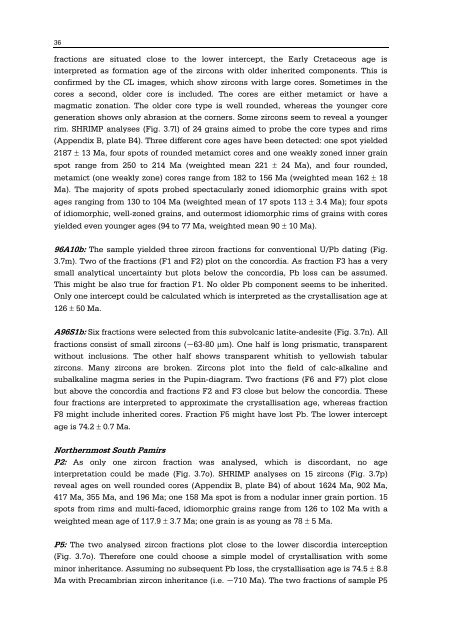tübinger geowissenschaftliche arbeiten (tga) - TOBIAS-lib ...
tübinger geowissenschaftliche arbeiten (tga) - TOBIAS-lib ...
tübinger geowissenschaftliche arbeiten (tga) - TOBIAS-lib ...
Create successful ePaper yourself
Turn your PDF publications into a flip-book with our unique Google optimized e-Paper software.
36<br />
fractions are situated close to the lower intercept, the Early Cretaceous age is<br />
interpreted as formation age of the zircons with older inherited components. This is<br />
confirmed by the CL images, which show zircons with large cores. Sometimes in the<br />
cores a second, older core is included. The cores are either metamict or have a<br />
magmatic zonation. The older core type is well rounded, whereas the younger core<br />
generation shows only abrasion at the corners. Some zircons seem to reveal a younger<br />
rim. SHRIMP analyses (Fig. 3.7l) of 24 grains aimed to probe the core types and rims<br />
(Appendix B, plate B4). Three different core ages have been detected: one spot yielded<br />
2187 � 13 Ma, four spots of rounded metamict cores and one weakly zoned inner grain<br />
spot range from 250 to 214 Ma (weighted mean 221 � 24 Ma), and four rounded,<br />
metamict (one weakly zone) cores range from 182 to 156 Ma (weighted mean 162 � 18<br />
Ma). The majority of spots probed spectacularly zoned idiomorphic grains with spot<br />
ages ranging from 130 to 104 Ma (weighted mean of 17 spots 113 � 3.4 Ma); four spots<br />
of idiomorphic, well-zoned grains, and outermost idiomorphic rims of grains with cores<br />
yielded even younger ages (94 to 77 Ma, weighted mean 90 � 10 Ma).<br />
96A10b: The sample yielded three zircon fractions for conventional U/Pb dating (Fig.<br />
3.7m). Two of the fractions (F1 and F2) plot on the concordia. As fraction F3 has a very<br />
small analytical uncertainty but plots below the concordia, Pb loss can be assumed.<br />
This might be also true for fraction F1. No older Pb component seems to be inherited.<br />
Only one intercept could be calculated which is interpreted as the crystallisation age at<br />
126 � 50 Ma.<br />
A96S1b: Six fractions were selected from this subvolcanic latite-andesite (Fig. 3.7n). All<br />
fractions consist of small zircons (~63-80 �m). One half is long prismatic, transparent<br />
without inclusions. The other half shows transparent whitish to yellowish tabular<br />
zircons. Many zircons are broken. Zircons plot into the field of calc-alkaline and<br />
subalkaline magma series in the Pupin-diagram. Two fractions (F6 and F7) plot close<br />
but above the concordia and fractions F2 and F3 close but below the concordia. These<br />
four fractions are interpreted to approximate the crystallisation age, whereas fraction<br />
F8 might include inherited cores. Fraction F5 might have lost Pb. The lower intercept<br />
age is 74.2 � 0.7 Ma.<br />
Northernmost South Pamirs<br />
P2: As only one zircon fraction was analysed, which is discordant, no age<br />
interpretation could be made (Fig. 3.7o). SHRIMP analyses on 15 zircons (Fig. 3.7p)<br />
reveal ages on well rounded cores (Appendix B, plate B4) of about 1624 Ma, 902 Ma,<br />
417 Ma, 355 Ma, and 196 Ma; one 158 Ma spot is from a nodular inner grain portion. 15<br />
spots from rims and multi-faced, idiomorphic grains range from 126 to 102 Ma with a<br />
weighted mean age of 117.9 � 3.7 Ma; one grain is as young as 78 � 5 Ma.<br />
P5: The two analysed zircon fractions plot close to the lower discordia interception<br />
(Fig. 3.7o). Therefore one could choose a simple model of crystallisation with some<br />
minor inheritance. Assuming no subsequent Pb loss, the crystallisation age is 74.5 � 8.8<br />
Ma with Precambrian zircon inheritance (i.e. ~710 Ma). The two fractions of sample P5

















